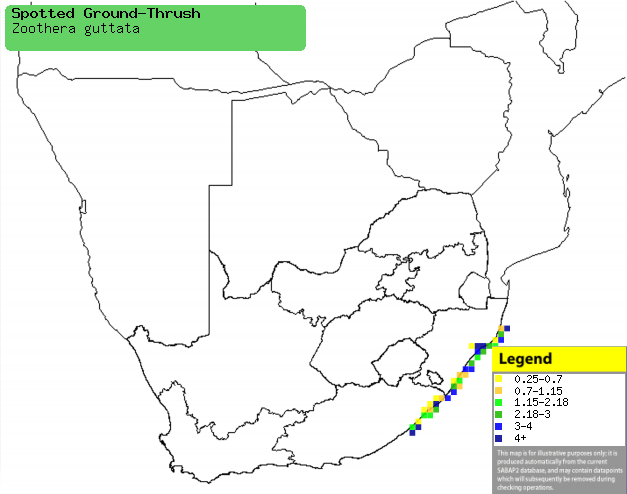|
Zoothera guttata (Spotted
ground-thrush, Spotted thrush)
Natallyster [Afrikaans]; umuNswi (generic term for
thrush) [Zulu]; Grive tachetée [French]; Fleckengrunddrossel [German];
Tordo-da-terra-malhado [Portuguese]
Life
> Eukaryotes >
Opisthokonta
> Metazoa (animals) >
Bilateria >
Deuterostomia > Chordata >
Craniata > Vertebrata (vertebrates) > Gnathostomata (jawed
vertebrates) > Teleostomi (teleost fish) > Osteichthyes (bony fish) > Class:
Sarcopterygii (lobe-finned
fish) > Stegocephalia (terrestrial
vertebrates) > Tetrapoda
(four-legged vertebrates) > Reptiliomorpha > Amniota >
Reptilia (reptiles) >
Romeriida > Diapsida > Archosauromorpha > Archosauria >
Dinosauria
(dinosaurs) > Saurischia > Theropoda (bipedal predatory dinosaurs) >
Coelurosauria > Maniraptora > Aves
(birds) >
Order: Passeriformes > Family: Muscicapidae
> Genus: Zoothera
Distribution and habitat
It has highly isolated populations scattered across
sub-Saharan Africa, in Sudan, Tanzania, Malawi, DRC and southern Africa. Here it
is rare, with an estimate population of only 400-800 pairs, scattered across the
coast of KwaZulu-Natal and the Eastern Cape. It only occurs in coastal dune
forest, scarp or lowland forest and any adjacent thickets; within these habitats
is most easily found in partially open areas with scattered saplings and a dense
canopy.
|
 |
|
Distribution of Spotted ground-thrush in southern Africa,
based on statistical smoothing of the records from first SA Bird Atlas
Project (©
Animal Demography unit, University of
Cape Town; smoothing by Birgit Erni and Francesca Little). Colours range
from dark blue (most common) through to yellow (least common).
See here for the latest distribution
from the SABAP2. |
Movements and migrations
Complex, with two separate populations
migrating separately:
- The first breeds in the Eastern Cape and migrates to the coastal forests
of KwaZulu-Natal in the period from April-May, returning again around
August-September to breed.
- Another population breeds around northern KwaZulu-Natal (centered around
Eshowe), moving eastwards around March-May for coastal forests, returning
later in August, when earthworms populations increase.
Food
It mainly eats earthworms, supplemented with other
invertebrates such as snails. It does most of its foraging singly or in pairs on
the forest floor, flicking over leaves in search of prey; it also occasionally
joins mixed-species foraging flocks, alongside
Terrestrial brownbuls
and Green-backed
camaropteras.
Breeding
- The nest is a large, messy cup built of rootlets, lichen, small twigs and
other plant fibres, neatly lined with small rootlets. It is typically placed
in a thin sapling in the forest understorey, such as a Narrow-leaved violet
bush (Rinorea angustifolia).
- Egg-laying season in the Dlinza forest, KwaZulu-Natal is from
September-April, peaking from October-February.
- It lays 1-3 eggs, which are incubated solely by the female for about
13-14 days.
- The chicks are brooded almost non-stop for the first 3-4 days, and are
fed by both parents on a diet of mainly earthworms. They eventually leave
the nest after about 13-15 days, at which point they flutter down to the
ground, where they stay for the next 7-10 days while being fed by the
adults.
Threats
Endangered globally and locally, as it has an
estimated world population of less than 2500 individuals and decreasing. It is
thought that fragmentation of coastal dune forest and predation of its eggs and
chicks by monkeys and raptors has at least partially cause this situation.
References
-
Hockey PAR, Dean WRJ and Ryan PG 2005. Roberts
- Birds of southern Africa, VIIth ed. The Trustees of the John Voelcker
Bird Book Fund, Cape Town. .
|
